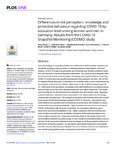Differences in risk perception, knowledge and protective behaviour regarding COVID-19 by education level among women and men in Germany. Results from the COVID-19 Snapshot Monitoring (COSMO) study
Rattay, Petra
Michalski, Niels
Domanska, Olga Maria
Kaltwasser, Anna
De Bock, Freia
Wieler, Lothar H.
Jordan, Susanne
The main strategy for combatting SARS-CoV-2 infections in 2020 consisted of behavioural regulations including contact reduction, maintaining distance, hand hygiene, and mask wearing. COVID-19-related risk perception and knowledge may influence protective behaviour, and education could be an important determinant. The current study investigated differences by education level in risk perception, knowledge and protective behaviour regarding COVID-19 in Germany, exploring the development of the pandemic over time. The COVID-19 Snapshot Monitoring study is a repeated cross-sectional online survey conducted during the pandemic in Germany from 3 March 2020 (waves 1–28: 27,957 participants aged 18–74). Differences in risk perception, knowledge and protective behaviour according to education level (high versus low) were analysed using linear and logistic regression. Time trends were accounted for by interaction terms for education level and calendar week. Regarding protective behaviour, interaction terms were tested for all risk perception and knowledge variables with education level. The strongest associations with education level were evident for perceived and factual knowledge regarding COVID-19. Moreover, associations were found between low education level and higher perceived severity, and between low education level and lower perceived probability. Highly educated men were more worried about COVID-19 than those with low levels of education. No educational differences were observed for perceived susceptibility or fear. Higher compliance with hand washing was found in highly educated women, and higher compliance with maintaining distance was found in highly educated men. Regarding maintaining distance, the impact of perceived severity differed between education groups. In men, significant moderation effects of education level on the association between factual knowledge and all three protective behaviours were found. During the pandemic, risk perception and protective behaviour varied greatly over time. Overall, differences by education level were relatively small. For risk communication, reaching all population groups irrespective of education level is critical.

